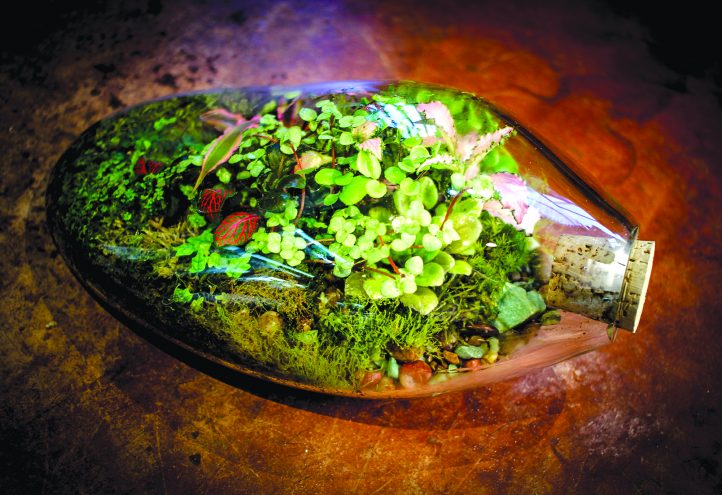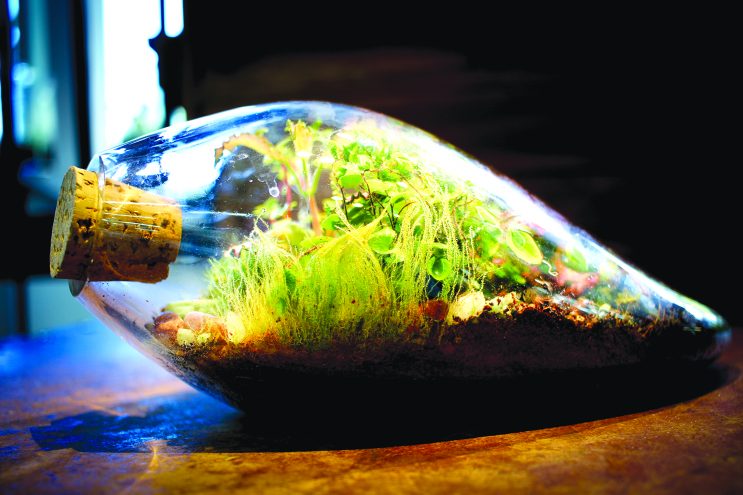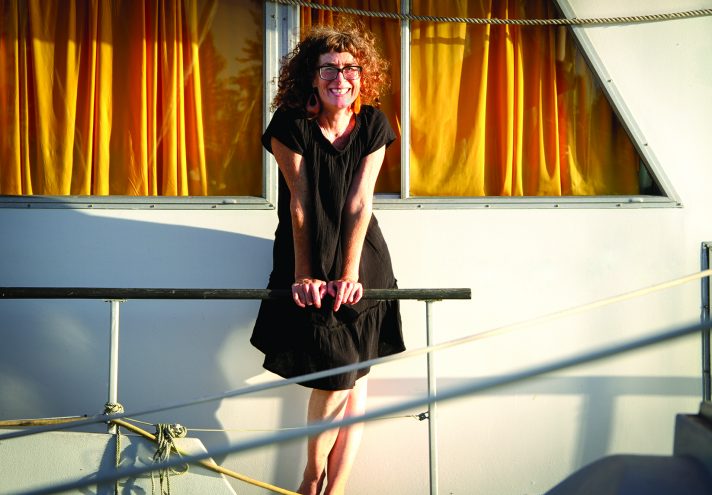Gregg Harris & Patricia Rubinelli


In a unique collaborative interview, ELEVEN got the pleasure of speaking with the team behind Roosevelt’s Terrariums. Gregg “Roosevelt” Harris is the creative botanist behind their exquisite compositions and Patricia Rubinelli is the artist that creates the beautiful glass pieces that frame these remarkable living pieces of art. A shop that has decorated the streets of our own Hawthorne Blvd for nearly three years now, Roosevelt’s Terrariums is a must visit. The shop itself is not very large, but what it lacks in size it makes up for in variety.
Gregg “Roosevelt” Harris
Eleven: What is the story behind getting Roosevelt’s started?
Gregg Harris: I learned how to plant terrariums as a runaway hippie kid in Laguna Beach, CA in 1969 and 70. At age 17 I was an informal part of the Sawdust Festival there, working with a young couple who made sand candles and macramé. The goal was to help people get back to nature by bringing tropical and woodland plants into their homes. Terrariums help keep the plants healthy much longer and with far less attention.
Later, in 1971, when I moved back to Dayton, Ohio, my wife and I started a Terrarium Shop when I was laid off during the Oil Embargo of 1973. It was a huge success and we became the richest hippies in town for about 4 years. That got me through college and into my career in educational reform.
This shop, Roosevelt’s Terrariums, was launched almost three years ago. My wife of 37 years died in 2010 and I had to change careers to stay home and be a better dad to my two youngest sons. The terrarium shop was our attempt to pull our family into some better routines together. We sold our big house in the country in 2013 and moved to Portland to start this venture. It has been an even greater success than the first time around, mainly due to our terrarium classes.
11: How have the changes in the Portland area impacted the store?
GH: Well, if by changes you mean “gentrification,” it has made a lot of things more expensive, but it has also brought a lot more upper-income buyers into the shop with enough discretionary spending to invest in a nicer and bigger terrariums. But it has also made it a lot harder for my neighbors who are caught in the rent cycle. Their income is not rising in step with their bills. Some are even homeless. But they are still my neighbors.
That’s why I have to create a wide range of terrariums to cater to the whole spectrum of incomes. Patricia’s glasswork is mainly for those at the higher end of the spectrum. But her work is worth a lot more than she is able to collect for it here in Portland. In New York City, where she is from, her pieces would easily be six to eight times higher than what we charge here. Maybe someday we will break out into the gallery art market for our terrariums. But until then we are having a lot of fun. We have plans to do some really amazing larger pieces along the lines of the New York terrarium artists.
 11: What impacts the aesthetic of a terrarium composition? Is it catered to a person?
11: What impacts the aesthetic of a terrarium composition? Is it catered to a person?
GH: I combine plants, soils, sands, gravels, mosses, and stones like a painter combines colors and textures on a canvas. If a person has a particular preference I take that into consideration. But if I was a musician I would not be a human jukebox. Great art does not match your couch. The terrariums I design and plant are intended to evoke respect for nature and a deep sense of awe at the beauty of the plants as they are.
11: Where do you get your plants and what type of criteria do you have for picking them?
GH: I get many of the plants I need by badgering established growers to give back to what they love. To repent and return, at least in part, to the reasons they got into horticulture in the first place.
My criteria are that the plants are beautiful, healthy and able to thrive in a closed, wet terrarium. I especially want plants that will maintain a miniature leaf that can also be easily trimmed whenever necessary. These plants are not often mass produced like poinsettias or fuchsia baskets.
Most growers don’t go into the tropical plant greenhouse business just to make money. They love the plants, especially the unusual plants. But over time, the pressure to make payroll can push any grower into mass production of one thing or another. The little family greenhouse becomes a big agribusiness, just like family farms become single crop factories, and the stuff the grower really loves gets pushed aside. I have been able to find a few growers locally who want to get back to that unusual stuff, at least as a side line.
But I also have to order a lot of rare material from faraway places in Florida, Texas, California and even New York and Kentucky. The shipping is a killer, but as long as I sell them as a small part of a much bigger and more expensive product, like a large terrarium, I can still keep things profitable. Roosevelt’s Terrariums is not competing with Fred Meyer, or even with Portland Nursery. We are competing with art galleries and high-end gift shops.
11: Are there any specific plants you like to work with the most?
GH: I love gesneriads. That family of plants includes flame violets, sinningia, and episcia as well as miniature African violets. I also love the creeping figs. The ficus family is amazing. Everything from rubber trees to tiny oak leaf creeping fig vines.
11: Would you consider yourself an artist or more of a botanist, or maybe a little of both?
GH: I have to be a lot of both. The form of my terrarium art has to flow out of the function of sound horticultural principles. Just as a dancer must work with the physics of gravity and the physical opportunities and limitations of human anatomy, I must work with a pallet of botanical colors, textures, and shapes that are still alive and growing. I have to anticipate that growth and work with it to keep the terrarium beautiful for a long time.
I also have to work with the challenges of container shapes and sizes, and the size of the opening and how it will eventually be closed. Patricia has been great at helping me bring all this together in a truly harmonious way. She gets the fact that the container is the “frame” for the picture I am painting with my plants, stones and mosses. She always allows my “painting” to be unencumbered. Her designs are amazing without being a distraction. Her designs support rather than compete with the plants, and the results are always magical. She can do anything. But like a great musician, she restrains herself to support the project.

11: Roosevelt’s Terrariums also has a strong community presence, not only because it offers community terrarium classes, and provides discounts to public service workers, but also because you provide Theodore Roosevelt’s character teach-ins for educational purposes and fundraisers. Why is it important to be connected with the community?
GH: Roosevelt’s Terrariums is founded on the simple truth that we do very well for ourselves simply by doing good for others. That is the only legitimate way to prosper. It is also intended to be a very social place where new friendships are being made every day with every kind of person who walks in the door or calls to book a terrarium class. It’s also a place for fellow enthusiasts and artists to find one another and collaborate on something worthwhile. It is also a place where I hope my sons will catch a glimpse of the beauty that is all around us in people and in nature.
Underneath all of this is my conviction that we are all headed into a cosmic tiger dimensional future where all that we will have to show for our lives will be our relationships with one another and our stories about those relationships. We are the conscious part of all that ever lived. Even when our minds fail us and we slip into dementia, our memories and insights into life are all safely backed up on God’s galactic hard drive. Nothing will be lost. No injustice will go unsettled. No one will get away with anything. And no one will ultimately lose out on what is right. I don’t just believe this. I know it to be true.
Community is just another way of saying relationships. We have a shared interest in making our family and our neighborhood and our city a great place for everyone to thrive. Nothing and no one are unimportant in this process. But there are some who are especially crucial and they are the artists and the musicians and the artisan makers. There is something theological about creativity. It requires vision and passion and perseverance to make art and all of those words are intensely theological, not religious, but Godly. Now if we can only see ourselves in our community as a never-ending work of living art.
Patricia Rubinelli
11: You have a wide range artistic endeavors, from photography to making the glass pieces for these beautiful terrariums. What got you involved with Roosevelt’s and with making glass pieces?
Patricia Rubinelli: In the early ‘90s I had been working on restoring stained glass windows in churches around Boston. It wasn’t long before I became more interested in making glass than the restoration process. Fast forward 30 years, I spontaneously walked into Roosevelt’s and met Gregg. I was grabbing takeout across the street and spied this beautiful corner store, all windows, bursting with plants. I felt enchanted immediately. It was clear to me after talking with Gregg for a few minutes that he’s a master botanist. The chance to collaborate with him has been a joy.
11: How has your background in photography contributed to your glasswork?
PR: For years I photographed light refracting through glass. The containers I used to create those refractions were recognizable forms. I wanted to make those lines and edges less associative. Initially, my goal was to create unusual forms for those images. Now when I make glass I consider how the light will pass through it–the two mediums ricochet off each other.
11: What made you interested in combining plants into your work?
PR: As far as the plants, that’s all Gregg. I wasn’t expecting that the lens quality of the glass would have combined with his designs. Once I saw that that worked, I created forms to accentuate that aspect. I’m always inspired working with clients. To understand the essence of their idea or vision enough to design a 3-D translation is very satisfying.
11: How is making 3-D art different from making art that is 2-D?
PR: With glass especially it’s the physical differences that set it apart. You’re working with something too hot to touch but can’t set it down. Being a liquid, it’s always moving, so you counter its movement by turning it constantly. There’s also the viscosity, which fluctuates by the second, so you’re responding to things you don’t have time to think about. When some of your most impactful tools are invisible (gravity, centrifugal force, breath), it’s an exponentially interesting situation.

11: Do you only make glass pieces for the terrarium shop or for other projects as well?
PR: I’ve relatively recently started making glass for terrariums. Before that, I had the honor of working for Chihuly and Lino Tagliapietra, in Seattle. In NY I mainly worked with designers, architects, and collectors.
11: What is the collaborative process behind making glasswork that matches a terrarium habitat?
PR: I try to make glass for Gregg that he will not be able to find anywhere else. I take into consideration the opening he needs to work with, whether or not it needs to be corked and how will the form hold condensation if it’s not corked. I like experimenting with creating interiors that will inspire his plantings.
11: How do shape and size play a role in the pieces you make?
PR: I don’t think as much about size or shape as I do about fluidity, the thickness of a piece and how it’s going to catch the light. If the glass itself feels alive and has a personality then that’s what I’m most happy with.
11: I have heard you also have a passion for vintage houseboats, can you talk about those?
PR: Yes, we live on a vintage houseboat, and have a sailboat from the ‘60s. Though as soon as I think about how much I love these boats, I think about how much I love living on the water—it’s an inseparable romance.




